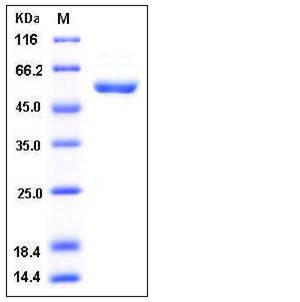Human CDC2 Kinase / CDK1 Protein (GST Tag)
CDC2,CDC28A,P34CDC2
- 100ug (NPP3728) Please inquiry
| Catalog Number | P10739-H09B |
|---|---|
| Organism Species | Human |
| Host | Baculovirus-Insect Cells |
| Synonyms | CDC2,CDC28A,P34CDC2 |
| Molecular Weight | The recombinant human CDC2/GST chimera consists of 522 amino acids and predicts a molecular mass of 60 kDa. It migrates as an approximately 53 kDa band in SDS-PAGE under reducing conditions. |
| predicted N | Met |
| SDS-PAGE |  |
| Purity | > 92 % as determined by SDS-PAGE |
| Protein Construction | A DNA sequence encoding the human CDC2 isoform 1 (NP_001777.1) (Met 1-Met 297) was fused with the GST tag at the N-terminus. |
| Bio-activity | No Kinase Activity |
| Research Area | Cancer |Cell cycle |Kinases/Phosphatases |Cyclin-Dependent Kinase |CDK |
| Formulation | Lyophilized from sterile 50mM Tris, 100mM NaCl, 0.5mM PMSF, 0.5mM EDTA, 0.5mM GSH, pH 8.0 1. Normally 5 % - 8 % trehalose, mannitol and 0.01% Tween80 are added as protectants before lyophilization. Specific concentrations are included in the hardcopy of COA. |
| Background | CDC2, also known as CDK1, contains 1 protein kinase domain and belongs to the protein kinase superfamily, CMGC Ser/Thr protein kinase family, CDC2/CDKX subfamily. CDC2 is a catalytic subunit of the highly conserved protein kinase complex known as M-phase promoting factor (MPF), which is essential for G1/S and G2/M phase transitions of eukaryotic cell cycle. Mitotic cyclins stably associate with CDC2 and function as regulatory subunits. The kinase activity of CDK1 is controlled by cyclin accumulation and destruction through the cell cycle. The phosphorylation and dephosphorylation of CDC2 also play important regulatory roles in cell cycle control. It is required in higher cells for entry into S-phase and mitosis. CDC2 also is a cyclin-dependent kinase which displays CTD kinase activity and is required for RNA splicing. It has CTD kinase activity by hyperphosphorylating the C-terminal heptapeptide repeat domain (CTD) of the largest RNA polymerase II subunit RPB1, thereby acting as a key regulator of transcription elongation. CDK1 is required for RNA splicing, possibly by phosphorylating SRSF1/SF2. It is involved in regulation of MAP kinase activity, possibly leading to affect the response to estrogn inhibitors. |
| Reference |
